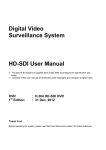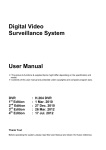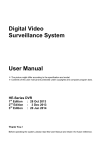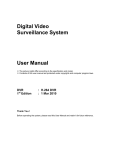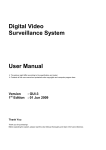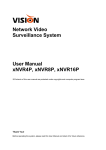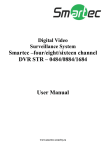Download Vision VHD-800X User manual
Transcript
Digital Video Surveillance System User Manual ※The picture & functions & supplied items might differ according to the specification and model. ※Contents of this user manual are protected under copyrights and computer program laws. DVR 1st Edition : H.264 HD-SDI DVR (VHD-400/800/1600/800X/1600X series) : 20 Apr. 2013 Thank You! Before operating the system, please read this User Manual and retain it for future reference. WARNING TO REDUCE FIRE OR SHOCK HAZARD, DO NOT EXPOSE THE UNIT TO RAIN OR MOISTURE. The installation should be made by a qualified service person and conformed to all local codes. Cautions Read Before System Operation Follow these details to prevent material damage or personal injury. Signs of Caution and Warning Warning: This sign indicates that the user could die or be seriously wounded if not used or installed properly. Caution: This sign indicates that the user could be wounded or could expect property damage if not used or installed properly. Warning: Do not expose the product to fog, rain or too much humid to decrease danger from electric shock or fire. General Warning Warning 1. Use the power cord, which is supplied or recommended by the supplier, or it may cause fire. 2. Do not disassemble or reassemble the product. It may cause malfunction or fire. 3. Enquire to your vendor for repair. It may cause electric shock or fire if the repair is not done properly. 4. Do not touch the product with wet hands. It may cause malfunction or electric shock. 5. Product installation must be ensured to a professional for product installation, or it may cause malfunction, electric shock or fire. 6. Ground applies to video products equipped with a 3-wire grounding type plug having a third (grounding) pin. This plug only fits into a grounding-type power outlet. If grounding is not done, it may cause malfunction or electric shock. 7. Ground connection must not touch gas pipe, water pipe or telephone line. If grounding is not done properly, it may cause electric shock. 8. Prevent metallic foreign substance from going inside the product. It may cause malfunction or electric shock. 9. Do not spray insecticide or flammable spray while driving. It may cause fire. 10. Place the system in a open place where air ventilation is guaranteed, or it may cause over-heating and seriously damage the system to be fired. 11. Prevent water from instilling inside electrical parts. Clean with a dry towel or malfunction or electric shock could result. Caution 1. Use the power cord, which is supplied or recommended by the supplier. The internal fan rotates at high speed and may cause an accident. 2. Do not drop, give strong vibration, or shock to the product. It may cause malfunction. 4 3. The air inhaler of the front panel and air outlet of the back panel must not be blocked during installation. The internal temperature of the product would be greater than allowable and could cause malfunction or fire. 4. Do not touch the product or the power cord when there is thunder. It may cause electric shock. 5. Do not install the product near or on top of heating source. The internal temperature of the product would be greater than allowable and could cause malfunction or fire. 6. Do not install the product on inclined or unstable location or where vibration could be committed. It may cause malfunction. Cautions about the Power Warning 1. Must use the outlet of the grounding to connect the power cord, or it may cause fire. 2. Do not connect on the middle of power cord or use extension cord. It may generate heat or cause fire. 3. Do not touch the power cord with wet hands. It may cause electric shock. 4. Keep power cord dry and protect from humidity. It may generate heat or cause fire. The power cord is not waterproof. 5. Hold the body of the plug while removing the power plug. Do not pull the power cord. Damage to the power cord may generate heat or cause fire. 6. Check the power plug regularly. Humidity and moderation in smoking may cause fire. 7. Remove power cord from outlet when product is not used for a long time. It may cause short-circuit or electric shock. Caution 1. Do not turn off the power by removal of the power plug. To turn off the power, click the power button from the front panel. When the system stops abnormally, the power button might not work. Click power button for 5 full seconds to turn power off. 2. Do not cut off the power artificially, or give shock or vibration to unit while the hard disk is activating. It may cause hard disk failure or loss of data. Remarks ※ Pictures and buttons are subject to be changed or modified up to different models. ※ Function or configuration is subject to be changed or modified without prior notice for improvement of the product. 5 Contents 1. GETTING STARTED .......................................................................................................................................... 6 1.1 CHECKING SUPPLIED ITEMS.................................................................................................................................. 6 1.2 SYSTEM STARTUP ................................................................................................................................................. 7 1.3 SYSTEM SHUTDOWN ............................................................................................................................................ 8 2. OPERATION ...................................................................................................................................................... 10 2.1 USER LOG-IN ..................................................................................................................................................... 10 2.2 LIVE DISPLAY MODE .......................................................................................................................................... 11 2.3 SEQUENCE ......................................................................................................................................................... 14 2.4 SEARCH RECORDED IMAGE ................................................................................................................................ 15 2.5 PTZ OPERATION ................................................................................................................................................ 18 2.6 DIGITAL ZOOM ................................................................................................................................................... 18 2.7 ALARM OUT ...................................................................................................................................................... 19 2.8 PLAYBACK RECORDED IMAGES .......................................................................................................................... 19 2.9 BACKUP DURING PLAYBACK ............................................................................................................................... 20 3. 4. SETTING ............................................................................................................................................................ 21 3.1 SYSTEM ............................................................................................................................................................. 21 3.2 DEVICE .............................................................................................................................................................. 28 3.3 RECORD ............................................................................................................................................................. 35 3.4 NETWORK .......................................................................................................................................................... 38 3.5 BACKUP ............................................................................................................................................................. 46 3.6 EASY SETUP ....................................................................................................................................................... 48 Q & A................................................................................................................................................................... 49 6 1. Getting Started 1.1 Checking Supplied Items Make sure that you have following items supplied with your DVR. If any of these items is missing or damaged, notify your vendor immediately. Keep the packing utilities for moving or storage purposes afterwards. Items Photo User Manual and Remote Software Quantity 1 Set (*) Quick Manual and CD 12V D/C Adaptor and Power Cable 1 Set (*) In case of 16ch model, only Power Cable is included. IR Remote Controller and USB Mouse 1 Set 7 1.2 System Startup After connecting all peripheral devices, connect power cord to the DVR for system startup. Once the DVR is started, image will be displayed on the screen. To operate the DVR, login is required as the administrator. The factory default of password is “1234”. The factory default of user and password are “ADMIN” and “1234” respectively. Admin user can fully control the entire DVR system. Note Do not forget the administrator’s password that was set for the first time. In case the password is forgot, contact your local dealer for help. Caution It may take a few minutes to startup the system after turning on the power, in case that user sets the network configuration as DHCP mode but there is neither DHCP server in user’s network nor physical network connection. 8 1.3 System Shutdown To turn off the power, click “TOOL” button and then click “SHUTDOWN” in the GUI software as below. Do not pull off the power by pulling the power plug. When the system asks User & Password, input them which have the rights to system shutdown. 9 10 2. Operation 2.1 User Log-in Check the power connection. Input USER and PASSWORD for login after turning on the system. The factory default of user and password are “ADMIN” and “1234” respectively. Admin user is to fully control the entire DVR system. Note 1) LOGIN window will be permanently displayed in monitor as above picture until user logs in with the correct ID and password. 2) If DVR is set not to check the ID and password, login process is not necessary. Please refer to the “Section 3.1.2 User” for details. 11 2.2 Live Display Mode 2.2.1. Channel Selection Real-time live image can be seen by easy button operation after power-on. The images can be seen on real-time by 1, 4, 9, 16 screen. Whenever the channel mode icon in the menu bar or the layout mode in the pop-up menu is clicked, channel mode will be changed accordingly. By pressing [DISPLAY] button on the front panel, channel mode will be changed sequentially. [1 Ch] [4 Ch] [9 Ch] [16CH] To select a channel & see as 1 Ch mode, make double click of the left mouse button. To return previous screen mode after selecting certain full channel, make another double click of the left mouse button. 12 2.2.2. Menu(Tool) Bar When user place USB mouse pointer in the bottom of the monitor in live mode, menu(tool) bar will be appeared as below picture. [MENU] button on the front panel works the same. Sequence button makes screen display change, based on the current display mode, sequentially. To stop the sequence mode, click the same button again. Cross icon button means “instant (emergency) recording”, which is activate all events set in the DVR. If there is no event set in the DVR, this button doesn’t work. User can click the right-forwarded arrow button is recorded 10mininutes before. to automatically playback the video clip that Joystick icon button means “PTZ” mode, which is useful to instantly switch to PTZ control. In PTZ mode, “PTZ” icon is shown on the right-bottom corner of the screen. And, when the mouse pointer is moved to the middle-bottom side of the screen, control buttons will be shown. User can control pan/tilt/zoom and others such as focus, preset & iris by clicking the buttons with the mouse. Exit button leads user to exit the PTZ mode. In order to hide the menu bar, click button. Circle icon button means the HDD usage percentage by video recording. If it shows 60%, then 60% of HDD space has been used up for recording. 13 2.2.3. Icons In real time live mode, icons or messages will be indicated on the screen to notify the system mode or status. Below are the icon categories, which are indicated on the monitor. Icon to be shown at right-upper corner on each channel screen Icon to be shown at right-bottom corner on full screen. Continuous Recording Showing sequence mode All events(Motion, Alarm In, Panic) Recording Using Emergency Recording Audio Connected Channel Using PTZ Sensor Activated Motion Detected 2.2.4. Pop-up Menu User can click the right mouse button to pop up the menu as below. With this pop-up menu, user can use various functions(Layout, Auto Sequence, Search, PTZ, Alarm Out, Logout and move to Menu). 14 2.2.5. Video Loss “Video Loss” is shown on the display screen when camera is disconnected on a certain channel. If a channel doesn’t have a connected camera from the beginning, channel logo is shown. When camera is disconnected, warning sound shall be generated depending on the system setting. 2.3 Sequence When “Auto Seq” is selected, icon is shown on the right-bottom corner of the screen and display screen will be sequentially changed. 15 2.4 Search Recorded Image User can search recorded image by clicking the right mouse button and select Search button or clicking Tool button in the menu bar and select Search button. 2.4.1. Instant Search When the Instant Search is selected, DVR automatically playback the video clip that is recorded 10 minutes before. 16 2.4.2. Calendar Search User can select date and time to search for a certain image within the recorded image. The red colored date means there are record data on that day. When the date is selected, user can check the time which has record data by the blue colored column at the time bar. And user can move to the desired time to search by dragging the grey colored slide bar. 17 2.4.3. Event Search The Event search is used to find particular event, quickly and easily. In order to find a specific event, select a date/time and camera/event type. When the “Get Index” button is clicked, user can check events under the selected condition. After playback the searched data, click the right mouse button and select “Playback Exit” to return to live monitoring mode. 18 2.5 PTZ Operation User can get into PTZ mode by clicking right mouse button and selecting “PTZ” in the pop-up menu or select joystick button in the menu bar appeared in the bottom of the main screen. When the mouse pointer is moved to the middle-bottom side of the screen, control buttons will be shown. User can control pan/tilt/zoom and others such as focus by clicking the buttons with the mouse. Exit button 2.6 leads user to exit the PTZ mode. Digital Zoom User can Zoom-In a specific area with mouse operation. Select an area with left mouse button to Zoom-in. To exit to normal live display mode, double click the left mouse button. 19 2.7 Alarm Out User can manually activate every single relay and beep sound of the DVR. At “Alarm Out” of the pop-up menu, click the relay number to activate that relay operation. To stop the operation, click the relay number again. When the “Buzzer” is clicked, DVR makes a beep sound. Click “Buzzer” again to stop sound. 2.8 Playback Recorded Images To playback recorded image, press Play button on the menu bar. Then, the recorded images of 10minutes before will be played. In the playback mode, channel mode change, search function and back function is available. 20 2.9 Backup during Playback User can easily archive video while watching video playback. In playback mode, user can click Backup button on the menu bar or select Backup in the pop-up menu start backup setting. Select time/channel & media (USB or CD/DVD) to backup. Backup file is saved as “.exe” file to check at the PC, automatically. 21 3. Setting General setting structure consists of “System”, “Device”, “Record”, “Network”, “Backup” and “Quick Setup” as below. Main Classification SYSTEM DEVICE RECORDING NETWORK BACKUP EASY SETUP 3.1 Sub Classification INFORMATION USER EXPORT/IMPORT HDD DEFAULT CAMERA AUDIO SENSOR MOTION EXTRA ALARM PTZ CAMERA SCHEDULE NETWORK DDNS NTP NOTIFICATION BACKUP EASY NETWORK EASY RECORDING System User can find the menu button on the menu bar or pop-up menu of mouse right button. User can move mouse pointer from “System” through “Easy Setup” to instantly look around the sub-menus in the menu screen. 22 3.1.1. Information DVR NAME User can designate the DVR name by using virtual keyboard as below. DVR ID User must setup DVR ID to match with the ID setting of IR Remote Controller, if user wants to use it to control DVR. 20(0~19) different ID can be set. Date Put the mouse cursor on the desired column(year, month or date) to be changed and change it by up/down arrow button clicking. Date Format / Date Separator User can change date display format. Time Put the mouse cursor on the desired column(time, minute or second) to be changed and change it by up/down arrow button clicking. 23 Time Format User can change time display format(12hours or 24hours). Language User can select language for menu. Current Version It shows the current firmware version. Update Firmware User can update firmware via USB memory Stick. Caution Do not click CANCEL button during firmware upgrade. It may cause serious damage on the system. Do not turn off the power of the DVR. It may cause serious damage on the system and DVR may not be turned on after that. The setting value might be changed to that of factory default. Therefore, it is recommended to check the setting value and operating condition of the DVR after firmware upgrade. Procedure How to upgrade system firmware by using USB memory stick 24 1) Put USB thumb-drive which was formatted by FAT/FAT32 in any USB port of DVR that shall be compatible with USB 2.0 version 2) Once the system detects the thumb-drive, user can see a new version after clicking “Read USB” button. 3) Click “Update” button to start update. (*) It is not allowed to use the partitioned and/or password-encoded USB memory. (*) Do not take the USB memory stick from the port during upgrade. It may cause serious damage to the DVR. 4) Once the update is finished, DVR will be restart automatically. Video Type It is for video output setting. User can select NTSC or PAL. IP Address It shows current setting value of IP address. User can change it in Network setting menu. MAC It is the unique identity number for each system and cannot be changed. Day Light Saving If it is required to set, check the Day Light Saving and click “Setting” to setup DST time. Monitor User can check Video Type and set VGA Resolution. VGA Resolution is applied to both VGA & Digital Output. 25 3.1.2. User The ADMIN user (default password is 1234) has got the full authority for system setting, and can change the system password or assign different permission level to each group. There are 6 different functions to be selected according to the permission level. Setup : Menu(System, Device, Recording, Network, Backup, Easy Setup) Playback : Channel setup for live monitoring & playback Network : Network setup Backup : Backup function Shutdown : System shutdown Logout : System logout New Group / Edit Group When the “New Group” button is clicked, new group with new name and functions allowed can be created. When the “Edit Group” button is clicked, existing group can be deleted or its functions can be changed. New User / Edit User When the “New User” button is clicked, new user can be added in a desired group. When the “Edit User” button is clicked, group or password can be changed and the user can be deleted. Checking The function which was checked in this menu requests User Name and Password whenever a user gets into the function. 26 3.1.3. Export/Import User can copy and paste the system configuration values in this menu. “Send Setup” allows user to copy the setting values of this system to USB memory devices. “Receive Setup” allows user to call up the setting values of other system from USB memory devices. During import process, make sure that the F/W version of source DVR has to be the same as the one of target DVR which user wants to import setting values to. “View Log” allows user to check log of the DVR. It can be copied to USB memory devices by clicking “Copy Log to USB” button. 27 3.1.4. HDD User can check model, total size, available size and status of the installed HDD. User can select “Overwrite” or “Stop” when HDD becomes full and also can easily format new HDD or existing HDD by clicking “Erase All Data” button. Note 1) The system always reserves some space in each built-in HDD to effectively utilize archiving memory. 2) When the format is done, all data in the HDD will be deleted. 3.1.5. Default When the overall change of configuration is required or the system operation doesn’t seem to be normal, user can make the system to factory default. The system setting will be originated by factory defaults. However, video data recorded are protected. 28 3.2 Device 3.2.1. Camera User can set each camera’s name, motion area and covert function, etc.. Name In order to distinguish the channel from the others, user can designate the channel name. Covert If a channel is set as COVERT, image is not displayed but channel logo is displayed. Sensitivity User can set the sensitivity for motion detection. Set(Motion Area) User can set motion detection area for each camera. The area can be selected by clicking block or drag of the mouse. The area can be set, easily, with pop-up menu that is opened by right mouse button click. If the new area setting needs to be saved, click “Save & Exit” button. If not, click “Exit” not to save the new area setting. “Copy to All” makes copy the current setting to all the other channels. 29 3.2.2. Audio User can select the usage of audio input. The number of audio channel may differ depending on DVR model. 30 3.2.3. Sensor It allows user to set alarm generation when the external sensor device, connected to the DVR, detects signal. On/Off Turn on or turn off the sensor. Camera Select the associated camera. Relay Select the associated alarm output. I. Rec(Intensive Recording) When alarm is triggered, system instantly assigns “remaining fps” to alarm-triggered channel and increases recording speed to maximum fps within the remaining fps. Preset User can select the camera to move to preset position, once the sensor is triggered. (User should setup preset position in PTZ menu.) Period Set the recording period from the start of sensor input activation. During this period, the corresponding camera image will record according to the frame and alarm (relay) output set. The recording stops and alarm output is turned off when the setting period is elapsed. PreRec Set recording period just before perceiving sensor input. The system records for a certain period of time prior to the time that alarm is activated, so that user can search video even before alarm is triggered. Type Select the sensor type between N/O(Normal Open) and N/C(Normal Close), connecting to alarm input plate. Circuit of N/O type is usually open, and the activation of the sensor occurs at the time of close, and N/C type works the reverse way. 31 Notification User can select how to be alerted upon sensor is activated by clicking “Notification” button. The system will generate buzzer sound in the selection of “Buzzer” and/or make pop-up screen of the camera in the selection of “Full Screen”. The system can send mail in the selection of “E-Mail”. Note Check the setting of the sensor type (N/O or N/C). The alarm might not work if the used sensor type and the system setting are inconsistent. In order to record whenever the sensor is triggered, “All Event” should be selected in schedule menu. In order to use Pre-Recording function, “PreRec” should be selected in schedule menu. 32 3.2.4. Motion Alarm Motion alarm is to start the recording when motion is detected by installed camera based on the area setting. The system will trigger alarm signal via the selected sensor-out channel. On/Off Turn on or turn off the motion alarm. Relay Select the associated alarm output. I. Rec(Intensive Recording) When alarm is triggered, system instantly assigns “remaining fps” to alarm-triggered channel and increases recording speed to maximum fps within the remaining fps. Period Set the recording period from the start of motion detection. During this period, the corresponding camera image will record according to the frame set. The recording stops and alarm output is turned off when the setting period is elapsed. PreRec Set recording period just before perceiving motion is detected. The system records for a certain period of time prior to the time that motion is detected, so that user can search video even before alarm is triggered. Skip User can set the time difference from the motion detection to the next motion detection. It can be set in between 1~15seconds. If the time is set, the next motion which is detected within the set time doesn’t activate alarm. Notification User can select how to be alerted upon motion is detected by clicking “Notification” button. The system will generate buzzer sound in the selection of “Buzzer” and/or make pop-up screen of the camera in the selection of “Full Screen”. The system can send mail in the selection of “E-Mail”. 33 3.2.5. Extra Alarm There are two extra alarm functions available on the system such as SMART & VIDEO LOSS. S.M.A.R.T It is to trigger alarm signal when HDD might be about to be out of operation. It can be notified via Buzzer and/or E-Mail. VIDEO LOSS It is to trigger alarm signal when the camera signal is disconnected. It can be notified via Buzzer and/or E-Mail. “Apply To All” make the same setting to all other channels. 34 3.2.6. PTZ User can set detail for connecting PTZ camera to the DVR. Check the below items for proper P/T/Z operation. Check if the protocol of the connected PTZ camera is correct. Check if the communication setting including baud rate of the connected PTZ camera is in accordance with the assigned value for that P/T/Z protocol. Check if the address of the connected PTZ camera is correct. Check if wiring to P/T/Z controllers is correct. Procedure How to setup PTZ camera with Pelco-D protocol (example) 1) Make sure of serial communication with the PTZ camera through RS-485 port. 2) Select “Pelco-D” in the protocol list, and set address & baud rate. 3) Click “Save” button to confirm this configuration. On Select to use the connected PTZ camera. ID Set the ID of the PTZ camera. Protocol Select the proper protocol of the connected PTZ camera. Baudrate User can select the baud rate level from 2,400bps up to 115,200bps. Databit Select Databit in between DATA7 & DATA8. Stopbit Select Stopbit in between None & STOP1. Parity Select Parity among None, ODD & EVEN. 35 Note PTZ operation works properly only when the PTZ setup in the DVR is the same as that of PTZ camera. 3.3 Record 3.3.1. Camera Recording Type User can select recording type among Continuous, Event & Pre-Event In case of Event & Pre-Event, user can set Period for each type. On Select to record each channel. Name In order to distinguish the channel from the others, user can designate the channel name. It can be set at the Camera in Device menu, either. Period It can be set for the recording type of Event or Pre-Event. When the event occurs, DVR records images during the set period for Event and Pre-Event. It can be set at each Device menu, either. Res(Resolution) User can set each channel’s resolution for recording. FPS User can set recording frame rate for each channel. Each channel can be set in between 1~30fps. However, the frame rate can be restricted depending on the DVR model. Quality There are four different quality levels for recording.(Low/Standard/High/Highest) User can select one of them in consideration of recording period, importance of each camera image and so on. Audio Select to record audio together with image. 36 3.3.2. Schedule Set recording schedule for each camera. User can set schedule for each camera, differently, or can set all cameras with the same schedule by “Apply To All” button. Recording can be set by each hour from 00 through 23 a day. Camera Select a camera to set schedule. Continuous In continuous mode, the system records all the time. It is shown with Red color. All Events(Motion, Alarm In, Panic) In this mode, the system records only when any event occurs. It is shown with Blue color. PreRec(Pre-Record) In this mode, the system records for a certain period of time, which is set at Camera or Device menu, prior to the time that event is occurred. It is shown with Yellow color. PreRec can be set independently. But, when the schedule is set along with All Events, the system records for a certain period of time before & after event occurs. Note PreRec cannot be set together with Continuous recording mode. 37 Table for schedule is divided into three rows as WD(weekday), WE(weekend), HD(holiday). Note Emergency Recording User can record instantly with Cross icon button in the Tool bar. When the Emergency Recording starts, system works the same as if all events occur. However, if no event is set, Emergency Rocording doesn’t work. During Emergency Recording, is shown in the right-bottom of the screen. 38 3.4 Network DVR can be connected to network or internet through either fixed IP or dynamic IP by proper setting of DVR & router. 3.4.1. Network Static/DHCP(Network Type) At the first startup the system, it is set as DHCP and searches IP. User can select either STATIC IP or DHCP for dynamic IP according to the network environment. MAC It is the unique identity number for each system and cannot be changed. IP Address Set the IP Address of the DVR. At the first startup, it shows dynamic IP which is assigned automatically. If user wants to use static IP, change it into Static and input IP address. Subnet Mask Subnet Mask address classifies the subnet that the system belongs to. In DHCP, it cannot be changed but, in Static IP, it can be changed. For more information, please consult your network administrator or your internet provider. Gateway This is the IP address of the network router or gateway server. It is required when the user wants to connect through external router. In DHCP, it cannot be changed but, in Static IP, it can be changed. For more information, please consult your network administrator or your internet provider DNS Server Enter the IP address of the Domain Name Server. User should input the DNS Server information in order to use DDNS, E-mail notify and NTP Server. If it is hard to know the correct information, user can input “8.8.8.8”. For more information, please consult your network administrator or your internet provider. 39 TCP Port It is for setting value transmission. Input the port number to use when connecting locally or remotely.(Default : 9020) It is for use with Remote Software P/C (RMS & CMS) & mobile device(MMS). UDP Port It is for image transmission. Input the port number to use when connecting locally or remotely.(Default : 9021) It is for use with Remote Software P/C (RMS & CMS). UDP Port number should be +1 from the TCP Port. (ex) TCP Port : 9020, UDP Port : 9021(TCP Port + 1) HTTP Port Input port number to use when connecting locally or remotely from Web Browser.(Default : 80) Transmission Method(Dual Streaming) Set the method one of two(By Quality or By Speed). User can control Fps and Quality for transmission. If the network transmission is not good enough, make lower the Fps and/or Quality. 40 3.4.2. DDNS User can use either a public DDNS server or the DDNS server operated by DVR maker (cctv-link.net) to connect through dynamic IP. It is recommended to use maker’s DDNS server for stable network connection. DDNS Server Type Default is “www.cctv-link.net” and user can change it into “dyndns.org” or “no-ip.com”. Input necessary information based on your network environment, and then click [OK] button. Note DDNS Server Type : Select one of three types and check at “Auto Sync”. DDNS Server : Select no-ip.com and input DDNS server that user has. DDNS Port : Default is 8245. Input the port number for connecting to DDNS according to the DDNS server type. User Domain Name: In case of “www.cctv-link.net”, input domain name to be used. And, click [Checking] button in the bottom to confirm whether this domain name can be used. User : In case of “dyndns.org” or “no-ip.com”, input registered user ID. Password : In case of “dyndns.org” or “no-ip.com”, input registered password. In order to use DDNS function, the accurate DNS server address should be required. 41 3.4.3. Router Setting (Port Forwarding) If user wants to use router for network connection, necessary Port Forwarding in the router (both static IP and dynamic IP) is required. The procedure described as below is just one of the example for the reference and the captured figures may differ depending on the model of the router. Please refer to the manual of the router for details. 1) Login to the router through M/S IE browser. 2) Go to the menu of [ADVANCED > Port Forwarding] 3) Do necessary Port Forwarding as below. (TCP Port & UDP Port & Web Port) For TCP Port of DVR If you use 9010 for TCP/IP Port (mentioned as above), then you have to forward Port # 9010 to DVR LAN IP. Note : If you change DVR TCP Port to 9020, you have to open and do Port Forwarding for 9020. For UDP Port of DVR If you use 9011 for UDP Port (mentioned as above), you have to forward Port # 9011 to DVR LAN IP. Note : If you change DVR UDP Port to 9021, you have to open and do Port Forwarding for 9021 If there are more than two DVR systems, each DVR should have different port number and separate Port forwarding. 42 For Web Port of DVR If you use 80 for Web Port (mentioned as above), you have to forward Port # 80 to DVR LAN IP. Note : If you change DVR Web Port to 8080, you have to open and do Port Forwarding for 8080. DVR needs several ports to be opened for remote image transmission, configuration and etc. Please refer to below port list to make sure that those ports are not blocked by firewall or other network setting. It may differ depending on the model of the router. Please refer to the manual of the router for details. Protocol Port TCP 9020 UDP 9021 TCP 80 Usage Data Transmission Port for Remote S/W Image Transmission Port for Remote S/W Web Service Remark Editable Location Basic Port Yes Network > Network Basic Port Yes Network > Network Web Port Yes Network > Network 43 3.4.4. NTP NTP function can use standard internet time server and “pool.ntp.org” is recommended. In order to use this function, select the timezone and click [Sync To Server]. Timezone Select correct Timezone. NTP Server Default is “pool.ntp.org”. NTP Server TIme Click [Query] button to receive current time from the NTP server. NTP Port Default is “123” Update It is for period setting to check the current time with the NTP server. User can select the period from 10 minutes to 24 hours. After setting the period, select [Auto Sync] to operate Update setting. 44 3.4.5. Notification DVR can notify the event to registered e-mail address. Receiver Click [Receiver] to register e-mail address to receive event notification. Click the empty column and input e-mail address with virtual keyboard and click [Add] button. If there is any e-mail address to delete, select one of them and click [Del] button. 45 Sender Click [Sender] to set server to send e-mail. SMTP Server Type / SMTP Server Select SMTP server. If user wants to use a specific server, select “User Defined” and input in the SMTP Server column with virtual keyboard. SMTP Port Input port number to be used for sending e-mail at the SMTP server.(Default : 587) If a SMTP server requires SSL authentication(ex, Gmail, N mail and so on), check at “Use SSL Connector”. User If a SMTP server requires login for sending e-mail, input user ID. Password If a SMTP server requires login for sending e-mail, input Password. Attach If a “JPG” is selected, e-mail attaches JPG file. Note Configuration first priority is always on “SCHEDULE” of “RECORD”. Thus, the system will not send email notification upon event occurs though user sets notification, unless user sets the “SCHEDULE” of “RECORD” and “MOTION”/”SENSOR” of “DEVICE” accordingly. For example, if user sets just “Continuous” only in “SCHEUDLE” of “RECORD” and setup the notification, then the system will not make email notification. In this case, user has to set “All Events” at SCHEDULE to enable Email Notification properly. 46 3.5 Backup 3.5.1. Backup User can archive video clip recorded for a certain period for a selected channel or channels to USB memory stick or CD/DVD. Backup file is saved as “ .exe” file to check at the PC, automatically. And the player program is saved together with video clip. Recording Period / Period Select starting date/time and ending date/time of images to backup. It can be set easily with calendar & time slide bar by clicking calendar icon. Type Select record file type one of two type(H.264 or JPEG). In case of JPEG, the image which is corresponding to the last time of the selected time is saved. Copy To Select backup media one of two type(USB or CD/DVD). Save As User can make file name to backup with virtual keyboard. Camera Select camera to backup or click [All On] to backup all cameras. Estimate It allows user to check the backup file size before starting backup. Note It is recommended to use built-in CD/DVD burner or well-known major brand of USB thumb drives formatted by FAT/FAT32 for proper backup. 1) The system does not detect external HDD due to different format type. 2) It is not allowed to use the partitioned and/or password-encoded USB memory. 47 3.5.2. Backup Video Retrieve After archiving, there would be file created as “ .exe”. Double click the file to play the backup images at the PC. 48 3.6 Easy Setup Easy Setup is to help user make easy configuration for network, recording mode & quality. The setting made by Easy Setup will get the first priority to apply on the system whatever user sets configurations in other menu. 3.6.1. Easy Network User can make network setup in this menu. For each setup, please refer to the “Section 3.4.1 Network” for details. 3.6.2. Easy Recording User can setup recording mode and quality for all channels at once. Note If the camera is set as “Off” in the camera setting menu, it will not be recorded even if it is set in the Easy Setup menu. Please check if any of camera is not recorded. 49 4. Q & A 1. There is nothing displayed on the monitor though electric power is supplied to DVR. 1) Please check if the power is supplied properly. When the power is supplied, you can hear the noise from FAN and HDD operation. 2) Please check the cable connection with the DVR. Remove all the cable connections, except for the monitor cable, and then apply power to the DVR again and check booting status. 3) In case that the display screen is stopped at logo screen, please contact your dealer or distributor. 2. Is it necessary to open the port when using DDNS (cctv-link.net, dyndns.org)? Yes, it is. DDNS is the function to let remote software acknowledge the changed address of the DVR (dynamic IP provided by ISP) or to allow connection to the DVR by sub domain (sub domain.cctv-link.net) without memorizing IP. 3. Remote software connection to the DVR works fine but WEB connection doesn’t work. 1) Some ISP blocks port number 80. Please try again after changing WEB port. (8080 or 8088 is recommended.) 2) Please check whether the WEB port is opened or not. 4. Image is not shown after login at WEB monitoring 1) TCP port and UDP port should be opened. Default of TCP/UDP port is 9020/9021. 2) Please check if Active-X is installed. In order to monitor image, Active-X is required. 5. DVR doesn’t record images in sensor mode and/or motion mode. 1) It records images only when there is an event for the corresponding mode. 2) Please check if the setting is correctly done at the menu of [Device > Sensor] and [Device > Motion]. 6. Backup or firmware upgrade through USB memory stick cannot be made though it is detected by the DVR. 1) USB memory stick should be formatted by FAT or FAT 32. 2) It is not allowed to use the partitioned and/or password-encoded USB memory 7. Time sync through NTP server doesn’t work. NTP server requires DNS server address. Please check if DNS server address is correct at [Network] tab. 8. E-mail transmission doesn’t work in using E-mail notify function. 1) E-mail notify function works based on SMTP service. Please check if the sending mail address is correct and if the mail server supports SMTP service. 2) SMTP service is provided based on DNS. Please check if the DNS server address is correct at [Network] tab.



















































